Did Macedonia’s Intelligence Agency stage a deadly shootout to distract from a corruption scandal? Three years after the Kumanovo incident, Benjamin Arifi sifts through the evidence.
Like many roads in ethnically mixed parts of Macedonia, Tode Mendol in the northern town of Kumanovo has two unofficial names. Ethnic Albanians call it “the Street of Brave Men”. To everyone else, it is “the Wild Street”. In the early hours of May 9, 2015, it became a warzone.
“The shooting started while we were praying,” recalled Eljesa Mahmudi, imam of the New Mosque serving the street’s mostly Albanian community. “We had no idea what was happening.” Around the corner on Pero Ilievski Street, an explosion awoke Ramadan Baftiu, a part-time taxi driver. The narrow cul de sac was swarming with police armed with Kalashnikovs. “I barricaded myself in the basement for around 14 hours while everything happened just outside,” he said.
Over the next two days, units of Macedonia’s anti-terrorist police laid siege to 39 ethnic Albanian gunmen holed up in three rented houses on Pero Ilievski. Wearing military fatigues and bulletproof vests, they burst into the home of Nezir Murtezi, a pensioner who lived two doors from one of the houses under attack. “The police shot from my terrace, from my living room, from my hall,” he said. “They went at it with everything they had.”
It turned out that 31 of the besieged gunmen were from across the border in Kosovo, veterans of war with Serbia in the late 1990s. They returned fire with sniper rifles, AK-47s and machine guns. The battle devastated the neighbourhood. Explosions turned houses to rubble and incinerated cars. Armoured vehicles crushed walls.
By 9 pm on May 10, 2015, when the last of the gunmen had surrendered, police casualties stood at eight dead and 37 injured. Ten of the gunmen, including the group’s leaders, were killed in the fighting, police later said. Nikola Gruevski, then Prime Minister, addressed the nation on live television. Grim-faced, he said police had thwarted a “terrorist group” that had snuck across the border, planning “massive killing” at police stations, shopping malls and sports events. “One thing is certain,” he said. “Their aim was to destabilise Macedonia.”
Three years later, with a new government in Skopje, there is anything but certainty about the motives of the gunmen. In early November 2017, the Skopje Criminal Court sentenced 33 men to a combined 745 years in prison on terrorism charges. Seven got life sentences while others received jail terms ranging from 12 to 40 years. Four men were acquitted. But the trial did little to answer a burning question on many people’s lips: who ordered the gunmen to go to Kumanovo in the first place? Who was behind it all? Nor did the trial quell calls for an international inquiry into the incident at a politically sensitive time for Macedonia as it seeks NATO membership and EU accession talks, both blocked by neighbouring Greece over a long-running bilateral name dispute.
Prosecutors had insisted the group acted on its own, bent on killing in the name of greater rights for ethnic Albanians in Macedonia. They had been under surveillance before attempts to arrest them turned into a bloodbath, they said. All the defendants had denied the terrorism charges, saying they acted in self-defence after police started attacking them. Some said they had been victims of a politically motivated set-up, lured to Kumanovo by Macedonian authorities where a trap awaited.
‘The conflict in Kumanovo was completely organised by the Macedonian Intelligence Agency.’
Even before the trial, speculation had swirled that the authorities may have orchestrated a showdown in Kumanovo — or at least tolerated the group’s plan to act there — to stoke ethnic tensions and distract from a corruption crisis engulfing the government of the day led by Gruevski and his VMRO DPMNE party. Among the conspiracy theorists was Zoran Zaev, then leader of the opposition Social Democrats, SDSM, and today prime minister. He told journalists a few days after the shootout: “There are strong indications that this case is a scenario orchestrated by the power holders.”
On the third anniversary of the incident, the Balkan Investigative Reporting Network, BIRN, can reveal exclusive comments from a senior officer of the Intelligence Agency that contradict the official account of how the gunmen came to be at Kumanovo. BIRN has been unable to independently verify the source’s information — and his version of events is strenuously denied by VMRO DPMNE leaders including Macedonian President Gjorge Ivanov. But taken together with court testimony, snippets of wiretapped conversations and forensic clues that some of the gunmen may have been summarily executed, his unconfirmed claims evoke a drama worthy of a spy thriller.
According to the officer, who spoke on condition of anonymity, the fighters in Kumanovo were recruited and armed with help from the Intelligence Agency, which gave them safe passage to Kumanovo before police forces pounced. “The conflict in Kumanovo was completely organised by the Macedonian Intelligence Agency,” the officer told BIRN. “It was a badly organised scenario that went even worse on the ground.”
BIRN put the claims, which are not substantiated with hard proof, to the Intelligence Agency. President Ivanov, who oversees the agency and heads the national Security Council, personally responded. Ivanov denied that the agency or the president’s cabinet had staged an incident in Kumanovo and called such accusations “a desperate attempt to mislead the news with false news and build a negative perception of the institutions”.
Zaev, whose SDSM-led government came to power in May, ending 10 years of rule by Gruevski’s VMRO DPMNE party, has said he favours a retrial. If that happens, the authorities have indicated they may request outside help to remove all remaining doubts about the case.
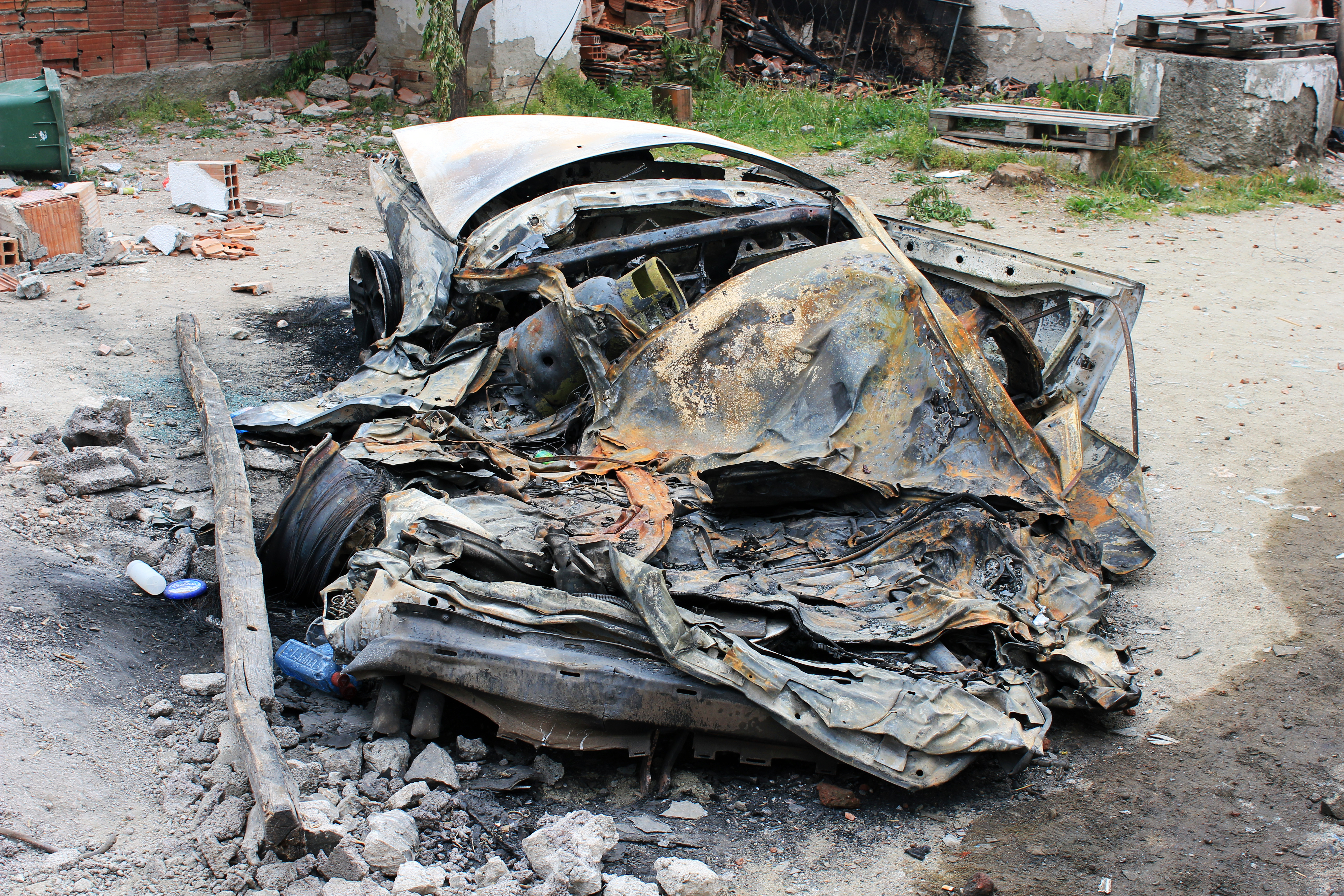
A destroyed car lies on a street in Kumanovo shortly after the standoff. Photo: © Amir Idrizi
Convenient timing?
As residents cleared debris after the shootout — broken glass, twisted metal, charred bricks — it was impossible not to recall the dark days of 2001.
The area around Kumanovo had been at the heart of a 10-month conflict in 2001 between state security forces and ethnic Albanian guerrillas of the now-disbanded National Liberation Army, NLA. A NATO-brokered peace deal helped Macedonia dodge all-out civil war, addressing many of the grievances that had fuelled the insurgency, including a lack of political representation for ethnic Albanians who make up at least a quarter of Macedonia’s 2.1 million people.
The 2001 peace deal made Albanian an official language in municipalities where ethnic Albanians make up at least a quarter of the population. It also guaranteed ethnic Albanians proportional representation in government and state institutions.
Countdown to Kumanovo
9 February 2015 – The government of Prime Minister Nikola Gruevski is engulfed in a corruption scandal as the opposition begins releasing leaked wiretaps that it says incriminate Gruevski and close associates.
4 April 2015 – Former police general Stojance Angelov tells protesters he has information that “someone” paid two million euros to ethnic Albanian “criminals” to impersonate a now-disbanded insurgent group and provoke inter-ethnic conflict in the Kumanovo region.
10 April 2015 – Government headquarters in Skopje is attacked by a grenade. Nobody is hurt.
11 April 2015 – Someone calling himself “Commandant Kushtrimi” takes responsibility for the grenade attack and warns of more bombings unless ethnic Albanians are given equal rights in Macedonia.
21 April 2015 – Forty masked gunmen cross the border from Kosovo and storm a police station in the village of Goshince, making off with a large supply of guns and ammunition.
26 April 2015 – Mirsad Ndrecaj, a former fighter from Kosovo’s war with Serbia, claims responsibility for the Goshince heist.
27 April 2015 – The ruling VMRO DPMNE party announces it will change the date of its party congress scheduled to take place in Kumanovo on May 9-10, bringing the event forward to May 2-3. Local media cite security concerns.
30 April 2015 – Opposition leader Zoran Zaev calls for a massive protest on May 17. Some 100,000 people are expected to attend. “This time we won’t go home until the government falls,” he says.
3 May 2015 – An explosion goes off at the headquarters of the largest ethnic Albanian party and partner in government in Tetovo. Nobody is killed.
5 May 2015 – The first of many big protests rock Skopje as public fury grows over the wiretap scandal, leading to clashes with police
9 May 2015 – Shortly before dawn, gunfire and explosions rock an ethnic Albanian neighbourhood in Kumanovo as anti-terrorist police battle 39 gunmen holed up in three houses. It is the beginning of a deadly two-day shootout. Even before the dust settles, critics accuse the government of staging the incident to divert attention from the wiretap scandal.
Photo: Bullet casings lie scattered on the ground in Kumanovo. © Amir Idrizi
In Kumanovo, where 20,000 ethnic Albanians account for almost half of the town’s residents, calm had reigned ever since. The events of May 9 and 10 raised the spectre of renewed ethnic strife. They also raised a question: why now?
In his speech to the nation after the shootout, Gruevski appealed to “those who criticise the opposition or the government to stop, because now we need unity”. Some critics found it all too convenient for the government.
Gruevski had been mired in scandal since February 2015, when then opposition leader Zaev started releasing what he called information “bombs” — batches of covert recordings that he said proved the government was behind the illegal surveillance of 20,000 people. The opposition claimed the leaked wiretaps implicated top officials in crimes including election fraud, abuse of power and covering up murder, which the government denied, saying the recordings were fabricated by foreign agents.
The wiretap scandal sparked furious protests and demands for Gruevski’s resignation. Critics wondered if the Kumanovo incident could have been a set-up to defuse efforts to oust him. Gruevski has denied all allegations, insisting the wiretaps were doctored recordings released as part of a plot to destabilise the country by unnamed “foreign secret services” in collaboration with his political opponents in Macedonia.
One of the wiretaps, released on May 15, 2015, is purportedly of a conversation between Gruevski’s cabinet chief, Martin Protugjer, and Interior Minister Gordana Jankuloska, in which they apparently toy with the idea of inciting a conflict. “Why don’t we make a war [with ethnic Albanians]?” Protugjer says to Jankuloska. “We could smash them in an hour!” Jankuloska replies.
A few days after the shootout, Jankuloska stepped down. So did Saso Mijalkov, secret police chief and Gruevski’s cousin. Both said their resignations had nothing to do with Kumanovo but were to help end the political crisis consuming the country, which they blamed on the opposition. Gruevski would himself go on to resign, in January 2016, as agreed in an EU-mediated deal to end the crisis caused by the wiretap scandal. In June 2017, he and close associates were indicted for election fraud and other alleged crimes.
If Kumanovo was a ruse to deflect criticism from the government, it had clearly not worked. BIRN was unable to contact Gruevski for comment but the VMRO DPMNE, of which he was president back then, responded to BIRN’s questions with a statement in November 2017. “The accusations of the then opposition are completely false and were part of their black campaign led by media under their control for a longer period,” VMRO DPMNE spokesman Ivo Kotevski wrote in an email. “Such allegations were part of well-prepared propaganda against the party, just to reduce confidence in it.
After all, neither then nor today, half a year since the SDSM came to power, has there been any evidence at all that would support an assertion that our party representatives were involved in orchestrating the event in Kumanovo.”
Goran Mitevski, director of Macedonia’s Counterintelligence Agency between 1999 and 2001, told BIRN in November 2017 that he had heard unconfirmed reports that the incident “was organised by high state officials”. The Counterintelligence Agency is a separate entity from the Intelligence Agency. Asked what the government would have stood to gain from staging such an incident, he speculated it might have been looking for an excuse to declare a state of emergency amid calls for early elections.
“But to prove all this, there needs to be an international investigation with the involvement of foreign experts or agents from the neighbourhood or from other foreign countries,” he said.
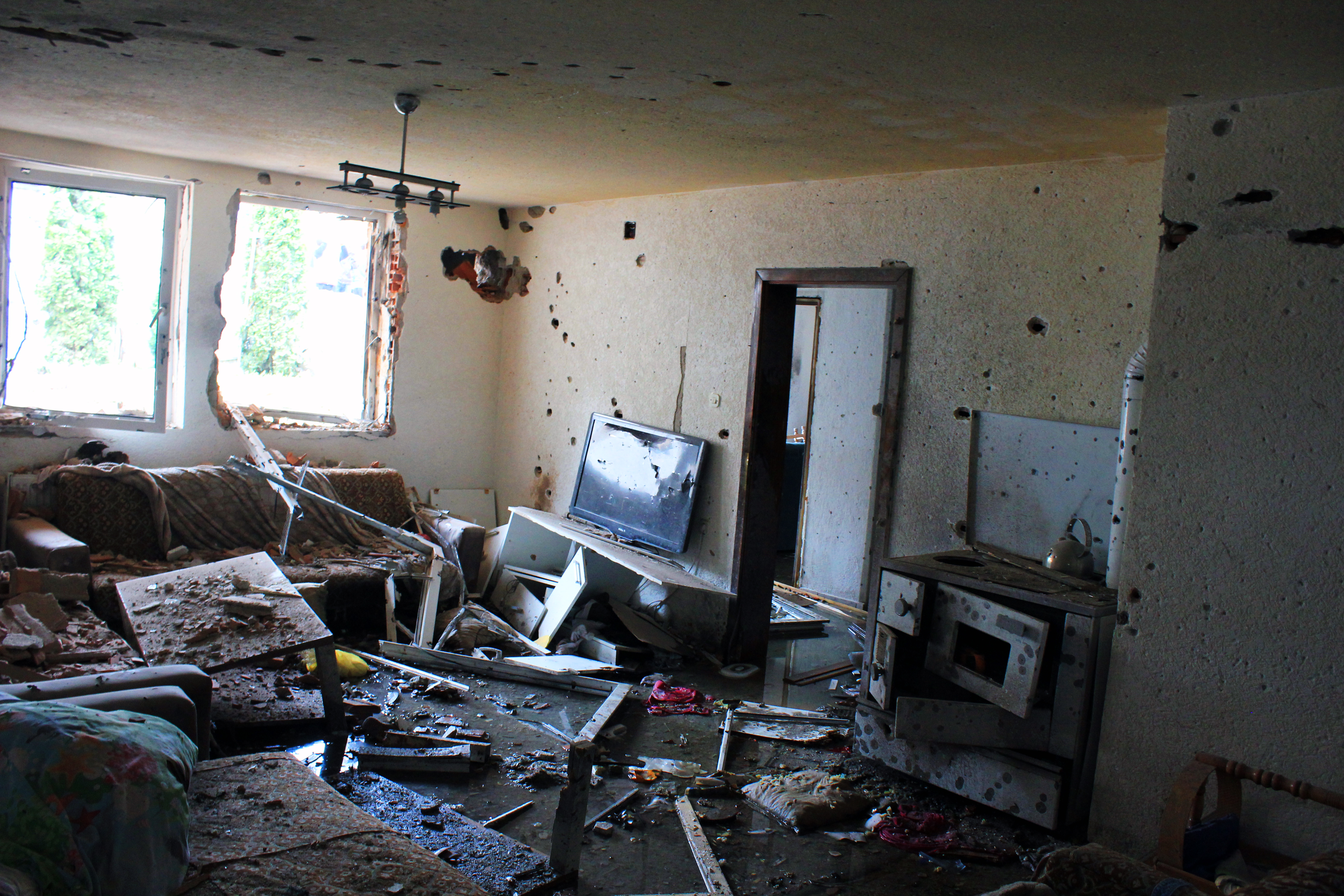
Inside one of the houses in Kumanovo where gunmen were holed up. Photo: © Amir Idrizi
Forewarnings
Even as bullets ricocheted off walls in Kumanovo, sceptics found reasons to be suspicious. Within hours of the siege, social media lit up with reminders of a speech made five weeks earlier by a former police general named Stojance Angelov. Little noticed at the time, it now seemed prescient.
The retired police general is the leader of a small opposition party called Dignity. On April 4, 2015, he had addressed anti-government protesters in Skopje. “Someone in our country has prepared a monstrous plan to cause an inter-ethnic conflict,” Angelov bellowed from the podium, without explaining who the “someone” was. “I have information that somebody gave two million euros to some Albanians who have nothing to do with the NLA, to some criminals from the Lipkovo region [near Kumanovo]. Their job will be to pretend to be NLA, and kill some police officers or soldiers, and cause an inter-ethnic conflict.”
In November 2017, Angelov told BIRN his information had come from “people who worked for state security and other services” and that he cross-checked it with other intelligence sources. The plan was to pay criminals to recruit — “as collateral damage” — a group of gullible and ideologically driven ethnic Albanians to launch attacks in Macedonia, ostensibly to defend ethnic Albanians from state oppression, he said he was told. “I said at the time that people close to the power holders were the instigators of this bloody act,” he said. “I believe that no one wanted to see this tragic outcome, but I believe that in the moment they lost control.”
‘Someone in our country has prepared a monstrous plan to cause an inter-ethnic conflict.’
Six days after Angelov’s speech, somebody threw a grenade outside government headquarters in Skopje. Nobody was hurt and damage was minimal. Someone calling himself “Commandant Kushtrimi” took responsibility in an email to media that bore the NLA logo and, bizarrely, the forged signature of the governor of the European Bank. Kushtrimi threatened further attacks until all Albanians had equal rights with Macedonians.
On May 3, 2015, a bomb went off in the northeast city of Tetovo at the headquarters of the Democratic Union for Integration, DUI, the largest ethnic Albanian party and a junior partner in the government. Nobody was killed or injured and no one claimed responsibility for the attack.
But it was on April 21, 2015 that supposed NLA fighters really made their mark. Police announced that 40 masked gunmen wearing NLA badges had crossed from Kosovo and stormed a police station in the village of Goshince, in the Lipkovo district near the border. They tied up and beat four policemen, before making off with the four-person outpost’s remarkably large arsenal of guns and munitions, including dozens of machine guns. The DUI warned ethnic Macedonians not to fall for what it called a “provocation”.
Macedonian news agency Zhurnal quoted the former commandant of the NLA in Lipkovo as saying the secret service had staged the Goshince incident to incite ethnic strife and rally Macedonians behind the government. “The government has paid some people to create a problem up there to manipulate public opinion,” he was quoted as saying.
In July 2017, the senior intelligence officer told BIRN the Intelligence Agency had encouraged the attackers to come to Goshince and steal the weapons, though he offered no proof.
Five days after the Goshince attack, a man named Mirsad Ndrecaj, subsequently identified as the late leader of the Kumanovo gunmen, posted a message on Facebook taking responsibility for the heist. “The NLA has always hit the target, where our enemies hurt the most,” he wrote. “We don’t want war, but when this is imposed on us, we will always be there protecting our beloved Albanian nation.” Authorities later confirmed that weapons seized in Goshince were used in Kumanovo. In addition to guns recovered in Pero Ilievski Street, police found 65 machine guns and eight rounds of ammunition from the same haul buried in woods near the town.
A day after the Goshince attack, the VMRO DPMNE announced it would change the date of its quadrennial congress, at which Gruevski was running unopposed for a fourth term as party president. The event had been scheduled to take place in Kumanovo on May 9-10 but was brought forward to May 2-3. Asked about the change of dates, VMRO DPMNE spokesman Kotevski told BIRN the party rescheduled the congress in response to the escalating political crisis that it blamed on the opposition, “in order to bring the full attention and focus of the party’s leadership onto the political crisis”. He said: “The party didn’t have any information about the group and their intentions to enter Kumanovo.”
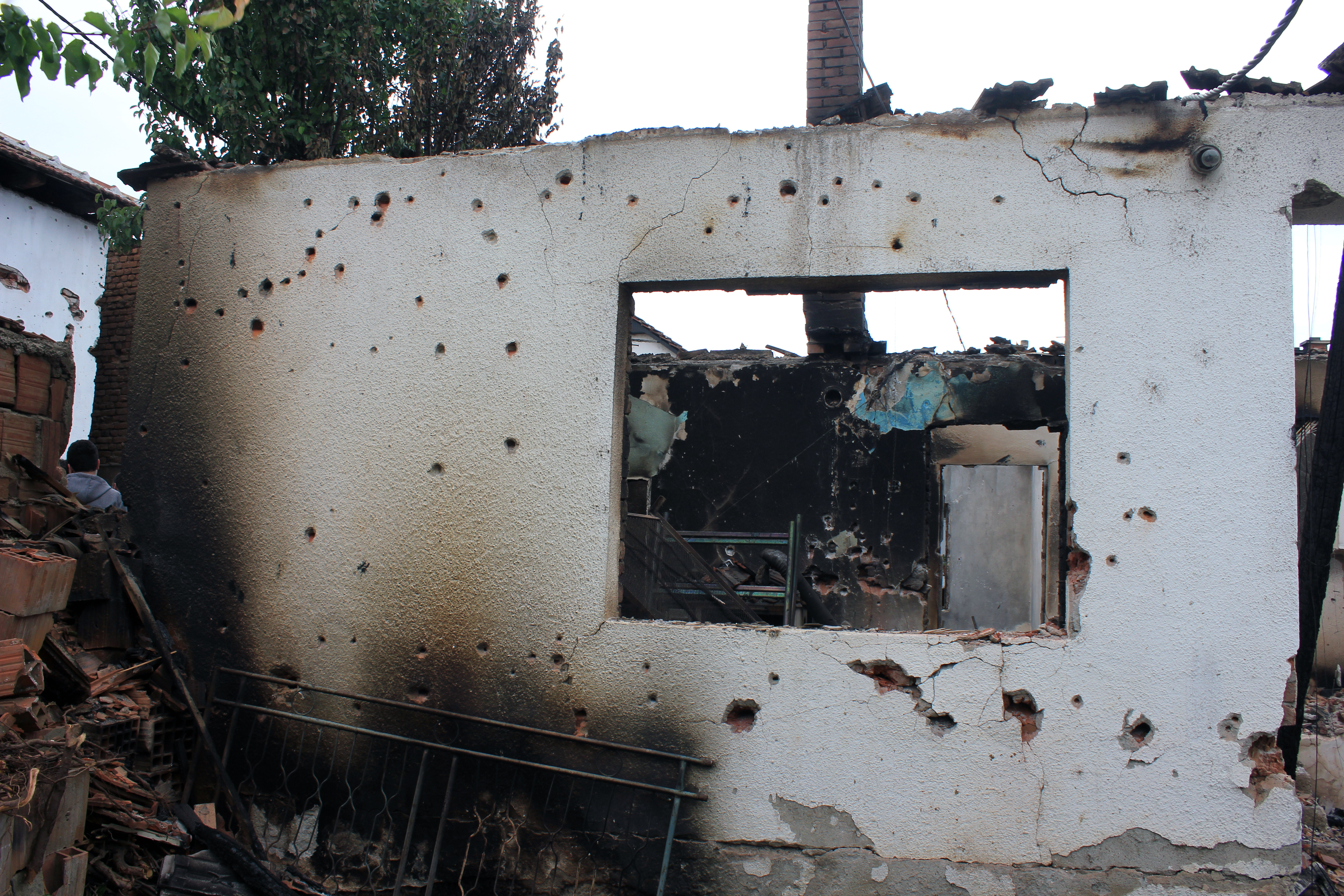
A wall pockmarked by machine gun fire shows the ferocity of the firefight in Kumanovo. Photo: © Amir Idrizi
Secret meeting
Ndrecaj, the leader of the gunmen, was a former fighter of the Kosovo Liberation Army during the conflict with Serbia. He was from the western Kosovo city of Gjakova/Djakovica. About a month after he was declared dead in Kumanovo, media in Kosovo published leaked recordings purportedly of phone calls between Ndrecaj and a man later identified in court as an ethnic Albanian agent working for Macedonia’s Intelligence Agency. The spy’s name was Shenasi Memedi.
“I sent you a message but that number of yours is not working,” Memedi says in one recording, apparently made soon after the Goshince hostage drama. “I saw the reaction yesterday evening.”
Ndrecaj: “Which one?”
Memedi: “The one you wrote on Facebook. That the NLA took over the station.”
Ndrecaj: “And? Did you like it?”
Memedi: “Very good, very good.”
BIRN was unable to contact Memedi, but the senior intelligence source claimed he was involved in planning the operation in Kumanovo. The senior intelligence officer identified another man as the “mastermind”: Sinisha Aleksovski, an agent in the Intelligence Agency who also sits on President Ivanov’s cabinet as his security advisor. “Everything was under the command of Sinisha Aleksovski, the president’s counsellor for security, and Shenasi Memedi on the ground,” he said.
Contacted by BIRN, Aleksovski declined to comment. In a television interview in May 2017, Prime Minister Zaev also linked Aleksovski to the Kumanovo incident. “Many structures are involved,” he said. “One is Sinisha Aleksovski. We heard a conversation between him and a person called ‘NATO Commander’ Mirsad Ndrecaj from Kosovo, a famous criminal and bandit who worked in these areas: Kosovo, Serbia, Presevo, Kumanovo, Tetovo region, Skopje — and they had communication.
“Why did they need to be in communication at all? There are serious indications for Sinisa Aleksovski. I think he is the head of the intelligence service that was with Gjorge Ivanov, but there are other indications of involvement of even higher structures.”
President Ivanov, who comes from the ranks of the VMRO DPMNE and has been head of state since 2009, denied that he or his cabinet had anything to do with what happened in Kumanovo. “Neither I as president nor my cabinet were involved in any way in the Kumanovo case,” he told BIRN in his written response to questions put to the Intelligence Agency. “The president is only a user of the information coming from the Intelligence Agency and other security services.”
‘Neither I as president nor my cabinet were involved in any way in the Kumanovo case.’
Ivanov continued: “From the generation of false news, next I expect them to associate me with the assassination of [US President John F] Kennedy. Point out at least one fact, not rumours, speculation and lies, but a fact that connects the Cabinet of the President with your allegations. “I want to inform the public, but also to send a message to all generators of false news: we will not sit with folded hands.”
Although Macedonia is a parliamentary democracy and the president’s powers are limited, Ivanov is commander-in-chief of the armed forces and head of the national Security Council. He also appoints the director of the Intelligence Agency. Critics see Ivanov as a close partisan of his VMRO DPMNE party. In March 2017, he sparked outrage by refusing to grant a mandate to Zaev after the SDSM won enough seats to form a government in alliance with ethnic Albanian parties. In May 2017, Ivanov finally relented.
The phone recordings published in Kosovo and picked up by Macedonian media allude to a meeting in Pristina, apparently between intelligence officer Memedi and group leader Ndrecaj.
Memedi: “Tomorrow I will be in Ferizaj [in southern Kosovo], with my wife, daughter and sons. I thought if you are in Pristina, or where are you?”
Ndrecaj: “We are in Pristina.”
Memedi: “I will call you tomorrow then, and we’ll meet somewhere for a coffee.”
Ndrecaj: “Okay, we will meet in Pristina.”
Memedi: “Say hi to Beg [Rizaj, another leader killed in Kumanovo].”
Ndrecaj: “He says hi back.”
In court, several defendants described at least one meeting in Pristina between Ndrecaj and the spy, Memedi. They said the purpose was specifically to prepare for Kumanovo, and that a meeting was captured on video. One of the alleged gunmen, Andi Krasniqi, spoke of a recording three hours and 17 minutes long. No such video has emerged.
“He [Ndrecaj] met Shenasi Memedi and another guy, Macedonian,” Krasniqi told the court. “I don’t know his name, but I know he is from the secret service.” Nasuf Bekiri, another defendant, said co-leader Beg Rizaj was also at the meeting. “That tape exists and will come out,” he said. “They planned the project, where they should enter, what they should do.”
BIRN asked the Intelligence Agency if its officers had met with members of the group in the run-up to the shootout. President Ivanov responded, saying: “Your question is to the wrong address.” He wrote: “Point the question to officials of international organisations and foreign embassies, state organs and political officials who have had constant communication with the leaders of the group. “Question them about the threats of assassination, extortion, blackmail, physical violence and why they didn’t report the events, the contacts and the nature of the conversations to the Agency of Intelligence and Ministry of Interior. There are many.”
Former Counterintelligence Agency director Mitevski said there was no way the gunmen could have made it to Tode Mendol Street in Kumanovo with all their weapons without the collusion of the Intelligence Agency. “When I say that there had to be support of the secret service, I mean that they had the chance to take action near the Kosovo border or in some other open space where civilian casualties would be eliminated,” he said. “According to the prosecution’s information, the group was followed by a drone entering Macedonia from Kosovo. The conclusion is that the secret service had secure information about the time and place the group would enter Macedonia.”
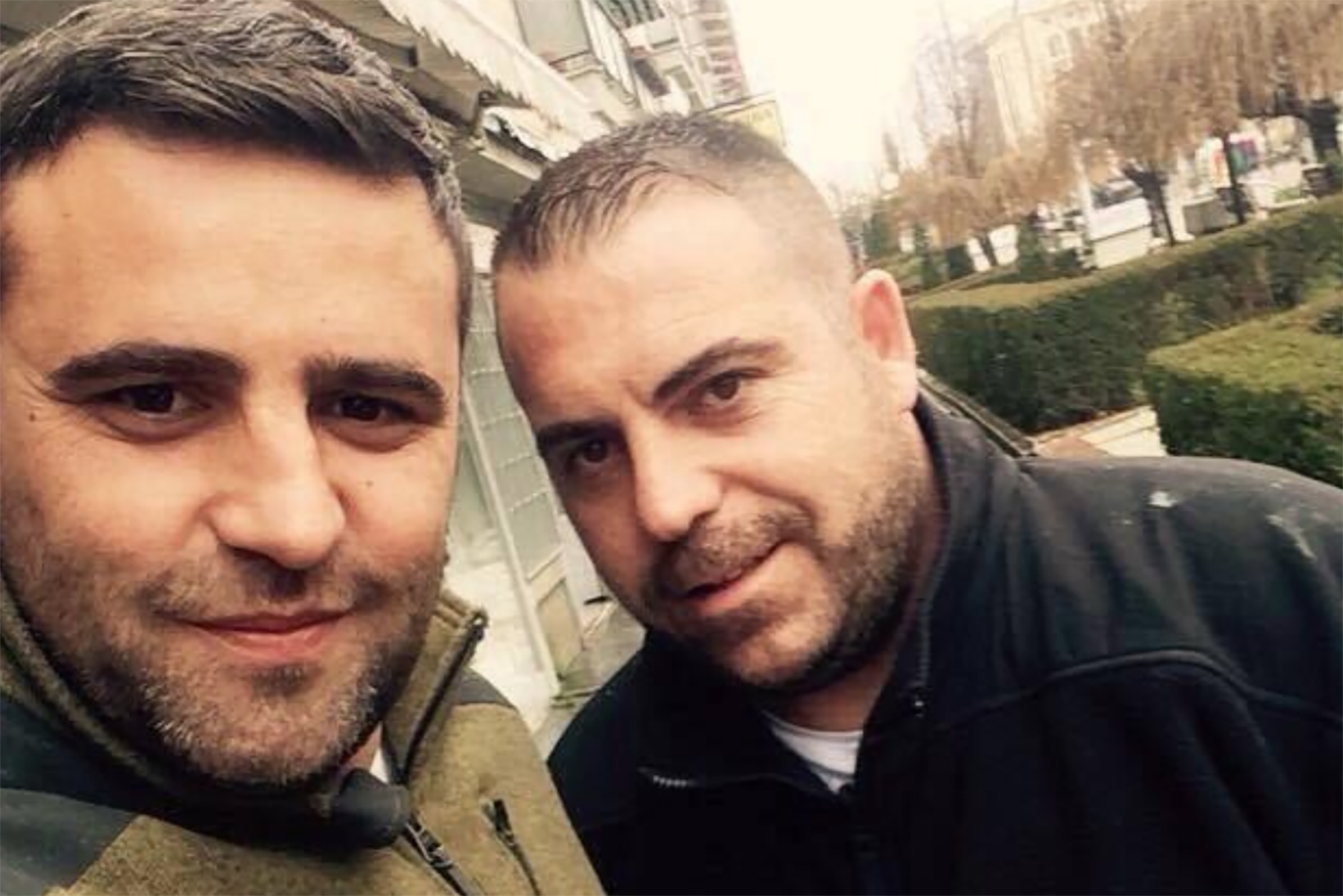
Beg Rizaj, left, and Mirsad Ndrecaj, alleged leaders of the Kumanovo gunmen, pose for a picture posted on Facebook.
Shots to the forehead
Without video proof and assuming the meeting happened as described, the only people who could confirm what was discussed were Memedi, the two leaders of the group and the unidentified second spy mentioned by the gunman Krasniqi. Memedi was excused from testifying in court on the grounds of state secrecy after his boss, Intelligence Agency Director Zoran Ivanov, sent a letter to the court. Mirsad Ndrecaj and Beg Rizaj are both dead. Mystery surrounds their deaths too. Court testimony and forensic evidence suggest they may not have been killed in the fighting as reported.
Two days after the shootout, Macedonia’s foreign ministry said in a letter to the Kosovo embassy in Skopje, seen by BIRN, that Ndrecaj and Rizaj were captured alive, along with a man named Arben Rexhaj who was later counted among the dead. The ministry subsequently called this a mistake.
Forensic reports shown to BIRN by a defence lawyer indicate that Rizaj and Rexhaj were both killed by a single bullet to the forehead. The reports give no idea of the distance the bullets flew before impact.“In my experience, the estimated distance is always written,” defence lawyer Naser Raufi said. “This is the first report I’ve seen without it.”
‘This closeness occurs only when someone is executed.’
Aleksandar Stankov, director of the Institute of Forensic Medicine in Skopje, which made the reports, disagreed that such information should have been included by default — though he said it was easy enough to calculate if required. “The distance of the shooting is not mentioned in the protocol, but the prosecution or lawyers could ask for this information,” he said. “They could have called us and asked for additional answers.”
Based on the reports and photographs, defence lawyer Raufi said it was likely the leaders were shot at close range. “This kind of similarity can only be achieved from a very near distance, for example one metre,” he said. “There is no possibility that this happened during fighting, as the prosecution asserts. The indictment says the fighters, or the executed leaders, were not face-to-face with the police at any moment of the battle. This closeness occurs only when someone is executed.”
Defendant Andi Krasniqi said in court that Ndrecaj and Rizaj were both alive as the last of the group surrendered at around 9 pm. Another alleged gunmen, Rufki Dogani, said he saw them alive in a police station after the shootout.
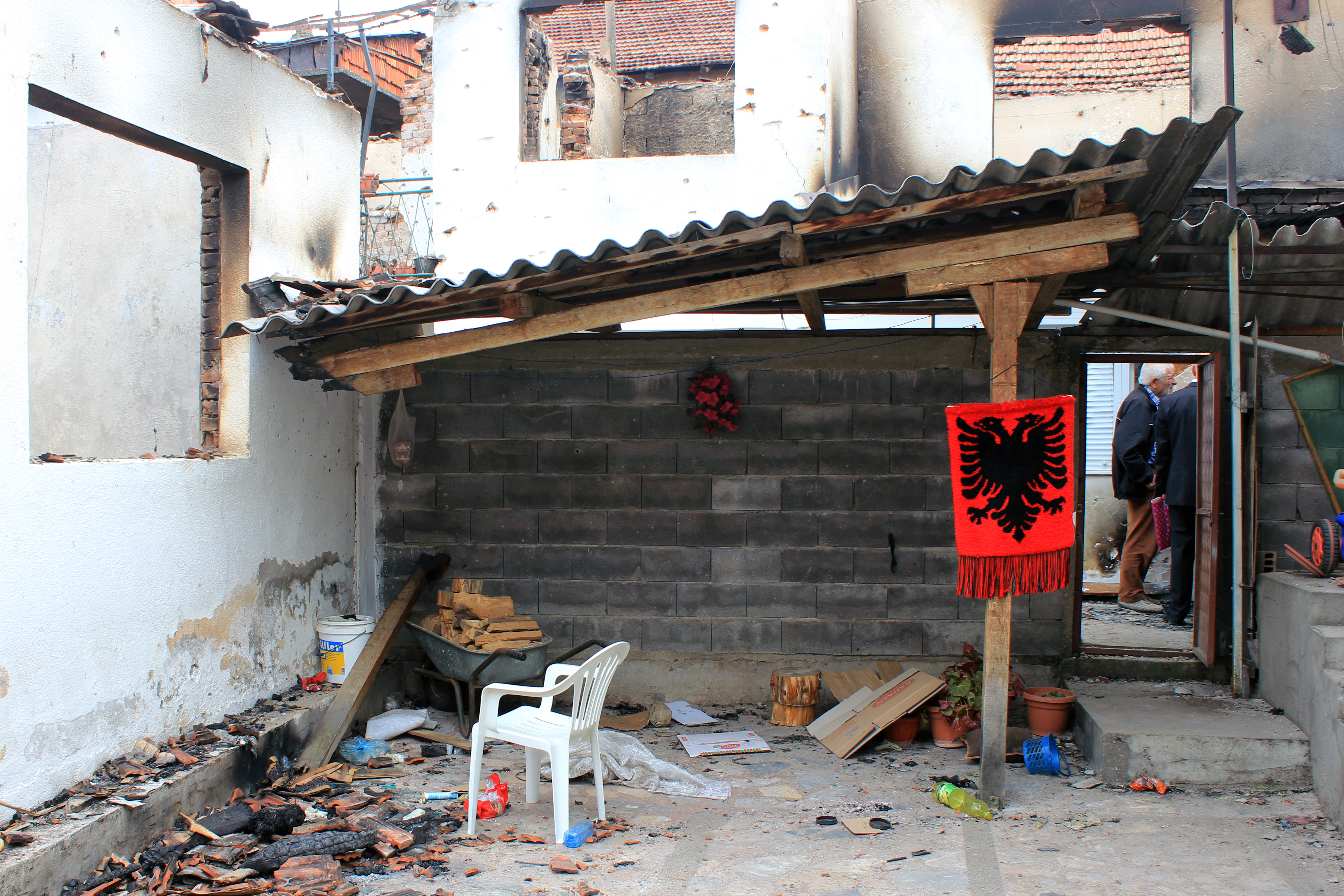
An Albanian flag hangs among the debris of a heavily damaged building. Photo: © Amir Idrizi
Conspiracy theories
Perhaps not surprisingly, relatives of the accused gunmen see them as heroes who went to Macedonia to fight for the rights of marginalised ethnic Albanians, only to be betrayed by the authorities who enticed them there.
Fadil Elshani, the father of defendant Bajram Elshani, came to Skopje in July 2017 to attend the trial. “Our sons came for patriotic reasons,” he said. “If they came here for terrorism, they would have killed children, old men or women.” Ylber Ndrecaj, the brother of the group’s leader, Mirsad, spoke to BIRN in Pristina after an event commemorating the two-year anniversary of the siege. “They didn’t go there on their own,” he said. “This case was approved by many politicians from Macedonia. And I’m telling you this based on very secure sources, not just rumours.”
Ethnic Albanians are not the only ones who think the siege was somehow orchestrated by Macedonian officials. Many non-Albanian residents of Kumanovo are cynical too. “They are people who got money to come to Kumanovo and provoke incidents, with the intention of causing a war in Macedonia,” said one man in Skopje’s main square. Even the father of one of the police injured in the shootout believed the conspiracy theories. “Everything was made up by politicians,” he told BIRN, declining to be identified. “Eight policemen got killed for nothing.”
Since the siege, destroyed homes have been rebuilt with red brick, thanks to a government compensation fund. One still stands in ruins, on the corner of Tode Mendol and Pero Ilievski. It belongs to Irfan Lutfiu, a barber who was sentenced to 14 years in prison for joining the group after they came to Kumanovo. Some hope to leave it untouched as a reminder of the carnage. “It was so terrifying,” said Imam Eljesa Mahmudi. “We’ll never forget what happened. This was a scenario that somebody prepared … Thanks to Allah there were no civilian casualties.”
Many people in Kumanovo and across the country now pin their hopes on an international investigation to settle once and for all what led to the shootout. In September 2017, Interior Minister Oliver Spasovski said he would ask for such an enquiry.“This would help the public find out the truth in a proper way,” he said. “It would be a procedure in which all citizens can believe”.
First published on 9 May 2018 on Balkaninsight.com.
This text is protected by copyright: © Benjamin Arifi . If you are interested in republication, please contact the editorial team.
Copyright information on pictures, graphics and videos are noted directly at the illustrations. Cover picture: Buildings stand in ruins in the Macedonian city of Kumanovo after a two-day firefight between gunmen and police that killed 18 people. Photo: © Amir Idrizi.
This article was produced as part of the Balkan Fellowship for Journalistic Excellence, supported by the ERSTE Foundation and Open Society Foundations, in cooperation with the Balkan Investigative Reporting Network.